L.L. Diamond's Blog, page 16
September 6, 2017
Blog Tour Kick Off!
Hi, everyone! I’ve been crazy busy getting Particular Attachments launched and I’m so excited to be starting the blog tour for it! I’ve got a fun schedule planned. It doesn’t just end on September 17th either! Not listed below are a review at Austenesque Reviews either later this month or in October, a guest post with Madame Gilfurt on October 2nd, and review at Obsessed by Mr Darcy in early October. I hope you’ll join me for each stop. There’s going to be something new with each blog 
August 7, 2017
West Stow Anglo-Saxon Village
West Stow Anglo-Saxon Village is an archeological site and museum dedicated to the artefacts and culture found in that area of Suffolk. There is evidence that people lived here as far back as the Mesolithic period, approximately 11,600 years ago, and that people have inhabited the area off and on throughout the ages.
In 1849, people became interested in the site and was excavated in the 18th and 19th centuries as well as a more recent excavation between 1956 and 1972. The majority of the structures that were once on this site were called sunken-feature buildings. There were also a great deal of coins as well as pottery found on the site. The museum displays some of these artefacts as well as others that they have found in nearby areas of Suffolk.
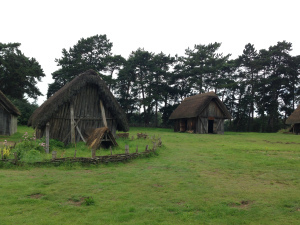
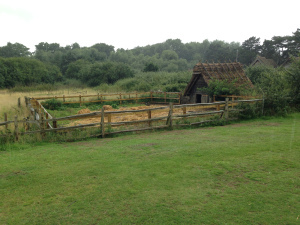
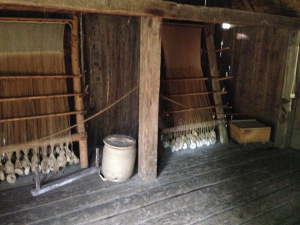
On the site now is a series of approximately seven buildings built by researchers in an effort to determine how the Anglo-Saxons built their dwellings as well as what kind of buildings they used. There are also replicas of the weapons used from the earliest times to the medieval times and re-enactments as a part of the tour, including everything from slingshots, to trebuchets, to gonnes, which were medieval hand cannons.


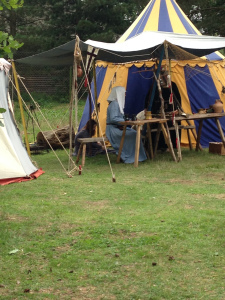
The area also comprises of 125 acres with trails, countryside, heath, which has purple heather on it right now, and walks to explore. There is also a playground, picnic area, and a cafe.
Sources:
https://www.weststow.org
http://news.bbc.co.uk/local/herefordandworcester/hi/people_and_places/music/newsid_9081000/9081966.stm
http://www.buryfreepress.co.uk/news/rotting-west-stow-house-reveals-anglo-saxon-builders-secrets-1-7008124
http://www.stedmundsbury.gov.uk/leisure/parks/weststow.cfm?aud=visitor
https://en.wikipedia.org/wiki/West_Stow_Anglo-Saxon_Village


July 17, 2017
Melford Hall
[image error]If you like Beatrix Potter, you might just find Melford Hall to be right up your alley. Built in the 16th century, Melford Hall was originally held by abbots until the dissolution of the monasteries when it was granted to William Cordell. It was passed and sold within the Cordell family until 1786, when it was sold to Harry Parker, the son of Admiral Hyde Parker and became the seat of the Parker baronetcy. The home was passed to the National Trust in 1960. The family still occupies a wing and some of the gardens by lease.
Beatrix Potter was a much-loved cousin of the Parkers and visited often after 1890. She was said to have brought mice and other creatures with her that she painted as well as painting or making pen and ink drawings of the house and gardens, which are on display in a small outbuilding as well as within the house itself. There is also a model of Jemima Puddle-Duck that she gifted the Parker children on one of her visits.
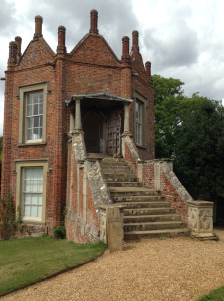
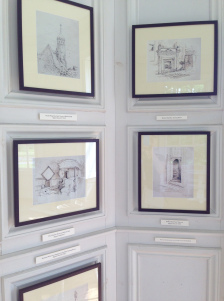

Along with the artwork, you can tour the room where Beatrix Potter stayed as well as many other rooms in the home. There is a small garden to the rear of the house that is tended by the National Trust and open to visitors as well as a small lawn to one side where there is seating for the tea room and room for people to play croquet. The National Trust also provides picnic blankets and Beatrix Potter themed toys for children to enjoy on the lawn as well.
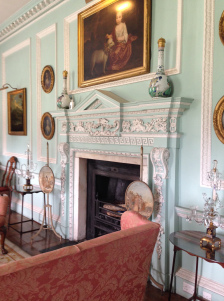
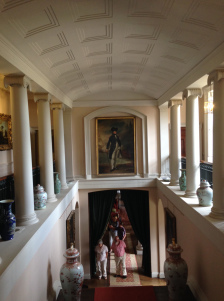
The house is lovely, though more modern in some ways than others. There are current photographs of the family around the house, which you don’t see in many of the other National Trust homes, and some of the furniture is more modern since family resided in many of the rooms toured until the ’60’s.
If you’re near Long Melford in Suffolk, Melford Hall is definitely worth a look–especially if you’re a Beatrix Potter fan.
Sources:
https://www.nationaltrust.org.uk/melford-hall
https://en.wikipedia.org/wiki/Melford_Hall
http://heartofsuffolk.co.uk/visitor-information/melford-hall-long-melford/


July 12, 2017
Sources of Inspiration: Idioms
When I first started writing Rain and Retribution, I didn’t think much about some of the phrasing I was using until my first beta tagged a phrase and asked, “When was this first used?” Wait, what? I never thought about some of the idioms or word phrases we might use on a daily basis and whether they were around in the time period I was writing. Now, I tend to catch myself as those pop into my head and I search them out and sometimes look for lists of fun phrases that would be more common during that time. Today, as I was editing a chapter, I looked up an idiom because I couldn’t remember if I’d checked it, and thought I would write a post with a couple of idioms I’ve had to check or that I’ve used just for fun.
Today’s idiom was “to turn up like a bad penny.” This actually comes from a proverb – “A bad penny always turns up,” and refers to anything or situation that is unwanted but recurs.
While we don’t consider pennies worth much, in the Middle Ages, they were worth significantly more and people counterfeited pennies, but instead of throwing them away, people would try to spend them to get rid of them. The term “bad penny” actually goes back further than the 14th century and can be dated by a poem by William Langland. In Piers Plowman, it says “Men may lykne letterid men… to a badde peny.
By the 18th century, the proverb appeared in Henry Fielding’s translation of Aristophanes Plutus (“We have a Proverb in English not unlike it, a bad Penny.”)
One of my favourites that I like to use is “different as chalk and cheese,” which is simply saying that things are extremely different. “Like chalk and cheese” dates back to the 14th century and found in John Gower’s Confessio Amantis, published in 1390, “Lo, how they feignen chalk for chese.” The origin has never been really discovered, but given the date it was first used in writing, it’s safe to say it was used in Regency England. I’ve even heard it used in the England today.
Sources:
http://www.phrases.org.uk/meanings/a-bad-penny-always-turns-up.html
https://english.stackexchange.com/questions/212498/old-timers-referring-to-a-bad-penny
http://www.phrases.org.uk/meanings/chalk-and-cheese.html


July 10, 2017
Particular Attachments has a Release Date!
I’ve been getting asked and I haven’t had an answer. Too many things were up in the air. I’ve been writing the story posting at Austen Variations, I hadn’t finished Particular Attachments, and I wasn’t sure if I was going to have to search out an editor! I finished and I was still superstitious about saying a release date out loud, but after a few things going my way, I decided to bite the bullet.
My editor is plugging steadily away despite the rigours of having a new baby, and I am starting the formatting as I get chapters back from her. I also have a pretty substantial blog tour (for me anyway) getting lined up around that release date. So when is this release date you ask? Mark your calendars because September 14th is the date!
I am super-duper excited and I hope you are too!
Thanks for reading!
Leslie xx


July 5, 2017
Sources of Inspiration: Artists as Modistes – Adélaïde Labille-Guiard
In my Regency novels, I have a lot of fun naming characters, but one of my favourites is naming the modistes for great female artists. I’ve used Lebrun, duParc, and in Particular Intentions and its sequel, Madame Guard for the portraitist Adélaïde Labille-Guiard.
[image error]
Self Portrait with two students (1749)
Adélaïde Labille was born in 1749 and was the daughter of a Paris shopkeeper (Coincidentally, her father owned a fashion boutique 
July 3, 2017
Winchester
During Jane Austen Regency Week several years ago, a group of us drove out to Winchester hoping to go inside the cathedral and pay our respects to Jane. Little did we know there is a flower show held ever other year at the cathedral and it was closed down the day we went to set up. I wanted to go again, but never made it back until this year. This year would normally be the year the flower show was held in Winchester, but I suppose the 200th anniversary of Jane’s death changed things a bit. Instead, the cathedral and all of Hampshire are celebrating Jane Austen.
I wish the weather had been cooler, but all of England was sweating out a heat wave for that entire week, and that Wednesday was no different. Intending to also go to the Mysterious Miss Austen exhibit, my daughter and I decided to go to the cathedral first since it was the closest. We stopped by the book bench in front of the cathedral first so I could snap a quick photo.
When we entered the cathedral, much to my surprise, my daughter was free because she is under 16 and with family. She’s at an age where she is rarely free or even reduced. She is still a student, so it’s always nice that something educational is made more affordable. 
June 28, 2017
Glenarvon
[image error] I always love finding little historical bits to add to stories for one thing or another. For my latest book, Particular Attachments, I had a scene in a bookshop and aside from researching actual bookshops in London at that time, I wanted Georgiana to find a book that would cause a little surprise that she would read it. While playing around researching books published in the few years before my story, I found Glenarvon, which fit what I was looking for.
[image error]
Lady Caroline Lamb
Glenarvon was a gothic novel published in 1816 and written by Lady Caroline Lamb. For those unfamiliar with the authoress, she is more commonly known as one of Lord Byron’s many lovers. She was born Lady Caroline Ponsonby and was a niece to Lady Georgiana Cavendish, the Duchess of Devonshire. When she was seventeen, Lady Caroline married the Hon. William Lamb, who was the heir of the 1st Viscount Melbourne.
Despite their marriage being orchestrated by her mother-in-law, it is said the two loved one another, and several theories exist as to why the marriage was far from a happy one. Lady Caroline gave birth to a premature daughter and later, a son with a mental impairment, who instead of sending to an institution, remained at home with them until his death. Some say this combined with her husband’s political ambitions sent Lady Caroline into the arms of another.
Another theory was that the Lambs expected to inherit the wealth and title of William Lamb’s father, which did not occur until after Lady Caroline’s death. Lady Caroline lived expecting riches she would never have and her husband indulged her, despite her tantrums and her affair with Byron.
One other theory was that William Lamb had unusual demands in the bedroom. Lady Caroline wrote in a letter to Lady Melbourne in 1810, “He called me prudish – said I was strait-laced, – amused himself with instructing me in things I need never have heard or known – & the disgust that I at first felt for the world’s wickedness I till then had never even heard of – in a very short time this gave way to a general laxity of principles which little by little unperceived of you all has been undermining the few virtues I ever possessed.” Rather ironic for someone who had a torrid love affair with another man.
[image error]From March to August of 1812, Lady Caroline Lamb and Lord Byron had a scandalous and very public affair. She described him as “mad, bad, and dangerous to know,” and he described her as “the cleverest most agreeable, absurd, amiable, perplexing, dangerous fascinating little being that lives now or ought to have lived 2000 years ago.” It is also said he admired her for raising her handicapped son at home rather than sending him away. They even considered fleeing the country and eloping in May of 1812.
When the affair ended, William Lamb took his wife to Ireland, but she still corresponded with Lord Byron. Upon her return to London, Byron refused to resume their relationship and eventually a scene occurred at Lady Heathcote’s ball in 1813, when Byron insulted Lady Caroline and she responded with an attempt to cut her own wrists.
At the time, physicians referred to Lady Caroline Lamb’s affliction as “erotomania” or a dementia caused by an obsession with a man, but her sanity was definitely called into question by her scandalous behaviour. Her reputation was not helped by the publication of Glenarvon three years later.
The characters in Glenarvon were said to be modelled after not only herself but also other prominent members of society. Lord Ruthven was an unfavourable depiction of Lord Byron, Calantha, the corrupted young bride, was Lady Caroline, and Lord Avondale was said to be her husband, the Hon. William Lamb. Her characterisations didn’t stop there, however, and many recognised themselves in the pages of her work and she paid a price for their inclusion. Lady Jersey, for example, excluded her from Almacks, and Lady Caroline never found her way back into society again.
Sources:
https://englishhistory.net/byron/lady-caroline-lamb/
http://www.sjsu.edu/faculty/douglass/caro/
https://en.wikipedia.org/wiki/Lady_Caroline_Lamb
https://en.wikipedia.org/wiki/Glenarvon


June 26, 2017
Jane Austen Regency Week 2017
I wish I could say that I was able to experience more than I did, but personal reasons interfered and I only managed two days of Jane Austen immersion this year. 
June 5, 2017
Flatford
I’ve been wanting to go to Flatford for some time. Run by the National Trust, Flatford is where the artist John Constable (1776-1837) painted approximately five of his works near the Flatford Mill. I happen to like Constable’s work and was intrigued by the gallery and the locations of his works. Along with the gallery and the scenery, Flatford also has the Bridge Cottage that people can tour as well as several walks and their tea room.
John Constable was born in nearby East Bergholt. His father owned Flatford Mill and several others according to the information on the site. He eventually married Maria Bicknell and moved to London, leaving the family mills to be taken over by his younger brother upon the death of his father.
Many of his works are set in Dedham Vale, which is the area surrounding Flatford, and represent a major contribution the Romantic movement of the time.
Driving to Flatford isn’t difficult, by any means, but eventually you reach a one-way single road carriage way that leads you to the car park. The entrance is quite close and once you are inside, a RPSB wildlife garden and the gallery are the first attractions.
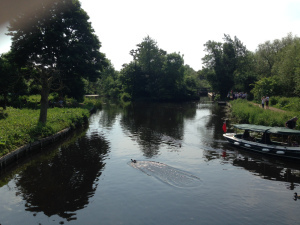
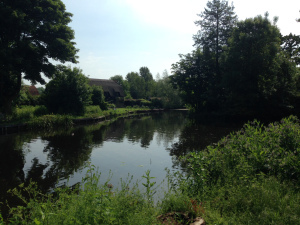
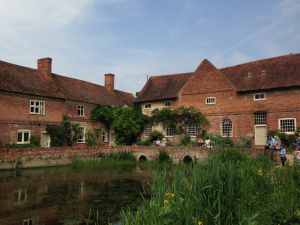
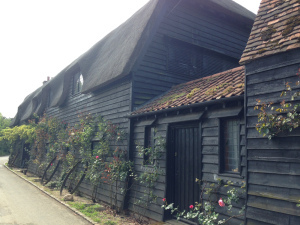
We opted to view the exhibition first, which is a great deal of infographics and large prints of his work. We then toured the Bridge Cottage and crossed the bridge and took the walk down past the locks before we turned around and walked the other main trail that takes you past the Flatford Mill and the site of the famous painting “The Hay Wain” as well as several other cottages and buildings that existed in Constable’s day.
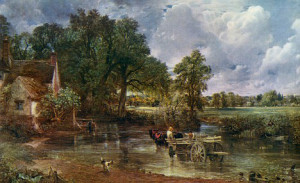
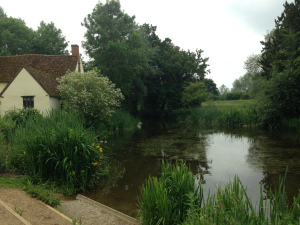
The site of “The Hay Wain” was fascinating by how much was actually the same from Constable’s day to ours. Obviously the trees are different, but the house to the side and so much is still the same.
After, we stopped into the tea room for a lite bite to eat and something to drink. We usually love the tea room, but found this one had no gluten-free offerings unlike most of the other tea rooms, which was a bit of a disappointment.
Our last stop was the RPSB Wildlife garden, that was full of colour, interesting, and beautiful, though I think the younger children enjoyed it more than us. It was still nice and had a great deal of educational bits on how to promote wildlife in your own garden.
Flatford is a gorgeous area if you are keen on hiking some lovely trails and for scenery. Dogs were all over the property and a few had a ball swimming in the River Stour and playing as well, so if you enjoy bringing your dog, then it’s a great place for it. There are also boat tours and row boats to rent. My son wanted to do the rowboat, but I didn’t realise how much it would cost, so be warned there is a £10 deposit on a row boat and then it’s £5 per half-hour.
Those who are interested in seeing Constable’s work might want to plan a trip to the National Gallery to see “The Hay Wain” or another gallery displaying his work since there isn’t any of that at Flatford.
National Trust site on Flatford: https://www.nationaltrust.org.uk/flat...





